Plants Are Not Created Equal
March 12, 2014 by admin
Filed under Garden Design, Perennials, Regional Gardening, Shade Gardening
Over the coming months I’ll be basing a number of blog posts, including this one, on material from my forthcoming book, The Shady Lady’s Guide to Northeast Shade Gardening. The official publication date is May 6, 2014. You can learn more about the book here, here and here.
In my last blog post I talked about a process of elimination I think gardeners should use in order to choose perennial plants for their gardens and why I believe that process will result in the best choices. The rationale behind it can be boiled down to a few simple words: plants are not created equal—at least not from an ornamental gardening standpoint. Some are much better garden performers than others.
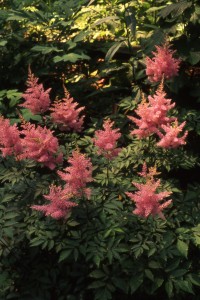
Astilbe is an excellent example of a backbone plant: it looks good all season and doesn't require tons of work.
It’s also important to realize that there’s no such thing as an ideal plant. You should no more expect perfection from a plant than a person, so you may have to give a little when it comes to your preferences.
Looking back at all the questions I said you should ask yourself when considering plants for your garden, I want to be clear that I’m not telling you there’s any plant for which all the answers will be what you want them to be. I’m just saying that for some plants a lot more of those questions have good answers, and those are the ones you should use to fill most of the space in your shade garden.
In fact, I have a name for these superior garden candidates: “backbone” plants. These are ornamentals whose exceptional qualities make them the best choices for filling the majority of the space in your garden. If you use them in abundance, they’ll hold your garden together and keep it solid, like a spine supports a body. Everything else, to one degree or another, is filler.
Strive to use backbone plants for at least 75-80% of your garden. Actually, you could build your garden from nothing but backbone plants, but for the sake of variety, you may allocate 15-20% of the space to secondary, filler plants that I refer to as “accent” plants. Finally, you can devote 5-10% of the space to a few annuals or tender perennials if you really feel the need to have them.
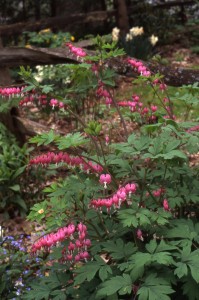
Old-fashioned bleeding heart is certainly a pretty face, but without staying power it doesn't qualify as a backbone plant.
So, what are some examples of backbone plants? I’ll give you two examples of backbone shade plants here, although this process of categorizing plants by their ability (or not) to deliver long-season performance applies equally well to sun as to shade.
The astilbe pictured above is a great example of a backbone shade perennial. It has strong, prominent flowers and attractive foliage, it’s not incredibly picky about growing conditions, it doesn’t require a lot of care, and it isn’t invasive. For those of us in the Northeast, its admirable cold hardiness is an essential quality, and the fact that deer generally ignore it is a godsend. Its only shortcoming is that it
really only flowers well in light shade at northern latitudes; in deep
shade, flowering will be minimal.
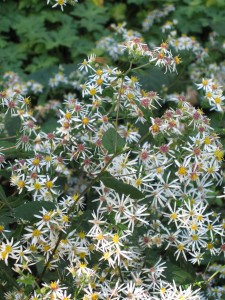
White wood aster is an underappreciated but very fine native backbone plant.
Plants like astilbe and white wood aster are reliable and unfussy—like friends who are easy to be with and always come through in a pinch. But you’ll notice that neither one gets “perfect marks.” As I pointed out earlier, it will almost never be the case that a plant perfectly suits all your needs and desires.
And they are not no-maintenance plants—there is no such thing in a garden setting. Each one has a rather predictable growth habit or behavior that will eventually demand your attention—astilbes often want division every few years, while white wood aster will migrate and have to be kept in bounds—but neither one will require an onerous amount of work. What they offer is a high likelihood of being successful additions to your garden, delivering steady results through the years while not making you regret ever planting them.
I know that this way of thinking about plants and plant selection may seem novel or even backwards to many readers. Gardeners are inundated with the message that gardening is all about personalizing your space and expressing your taste, not to mention the message that it should be cheap and easy, to boot (it generally isn’t, but that’s a topic for another blog post). While it’s certainly true that your garden should reflect your individuality, focusing too much on that obscures some inconvenient facts. Successful gardening means finding a manageable way to get good results given your budget of time and money, and for most homeowners that means putting functionality first.
I hope I’ve persuaded you of the value of using my approach. If you need a little more convincing, consider this: in the early years of my ornamental gardening experimentation, I bought a lot of plants I liked a lot and proceeded to…kill them. Mostly—because I was trying to determine the limits of their shade tolerance—I subjected them to inadequate light, and of course, a lot of them expired.
I feel kind of guilty about it now, but all that “horticide” did have a point: those sacrificial plants eventually taught me to categorize a wide range of shade perennials by both their needs and their performance potential for gardeners. In the process, I came to appreciate a whole new palette of plants for their ability to tough out the difficult conditions we Northeast shade gardeners face.
In my upcoming book, The Shady Lady’s Guide to Northeast Shade Gardening, I elaborate on the topic of what makes a superior shade garden perennial and how to use a wide range of shade plants to good effect. I hope that knowledge will help you find the best choices for your particular situation.
How (Not) to Pick a Plant
February 6, 2014 by admin
Filed under Garden Design, Perennials, Shade Gardening
Over the coming months I’ll be basing a number of blog posts, including this one, on material from my forthcoming book, The Shady Lady’s Guide to Northeast Shade Gardening. The official publication date is May 6, 2014. You can learn more about the book here, here and here.
When you pick perennial plants to put in your shade garden, how do you do it? Most people would start out by picking plants they like—and that’s where they’d make their first, and worst, mistake.
Huh? What? Surely I can’t be advising you to pick out plants you don’t like?! No, of course not. But think about this for a second. When you go shopping for a new car, do you just pick out the one you like the best? No—at least not if you’re like most of us. If that were all it took, we’d all be driving around in Ferraris and Lamborghinis. The problem with that approach is that most sports cars won’t do what most people need a car to do: get up a snowy hill on a winter day and deliver you to your job in one piece, or get enough miles to the gallon to not break the fuel budget.
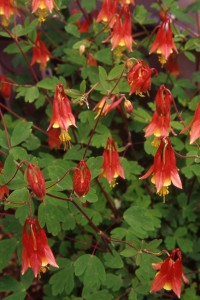
Flowers, flowers, we all like flowers—but there are many other important things to consider when choosing shade perennials.
In other words, we consider practical things. As weird an idea as this will seem to many people, you should do the same thing when you pick out plants—if you want your garden to look good with minimal effort and expense for the longest possible season.
Not all plants are equally good at doing that. In fact, for any given type of garden in any given region, only a small number of plants will give that kind of superior performance, in the same way that, in all likelihood, only a small number of cars will satisfy your criteria for budget and functionality.
So, what are the practical questions you have to ask when picking out plants? First, the more obvious ones:
• Is the plant cold hardy where I live?
• Does the plant prefer the conditions I can offer it?
It’s self-evident why these are questions you should ask first. It makes little sense to populate your perennial garden with plants that won’t be, well, perennial in your area. It also makes little sense to invest in plants that won’t be happy with the growing conditions you provide them. Matching plants to growing conditions is an essential part of the art of garden design. I’m not going to go into detail here about the fine points of that process; what matters is that you realize its importance.
What else do you need to ask yourself in order to pick the best perennials for shade? Here are a few more:
• Is the plant disease resistant?
• Is the plant prone to insect infestation?
• Is the plant unpalatable to deer and other potential browsers?
• Does the plant spread or seed aggressively?
• Does the plant typically go dormant before first frost?
• Does the plant have foliage that looks good all season long?
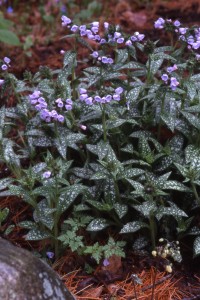
Powdery-mildew resistant Pulmonaria 'Roy Davidson'
The benefits of disease and pest resistance are obvious. Lungworts (Pulmonaria, see photo at left), for example, have unique speckled foliage that can brighten shady nooks and crannies, but most of them are prone to a disfiguring fungal disease called powdery mildew that leaves them coated with an unattractive whitish film. Luckily, some lungworts are resistant. If you buy only the resistant ones, you’ll be able to enjoy the beauty of disease-free lungworts, and you won’t have to expend extra effort to keep them that way.
It’s the same story for all the other questions above. By carefully selecting plants that aren’t palatable to most insect pests and browsing animals, you eliminate the need to take action to stop various critters from nibbling. Likewise, you reduce the need for work (and increase the percentage of your time in the garden devoted to enjoying it) by avoiding overly aggressive spreading plants.
Finally, as a general rule plants that perform well over a long season should be given priority over those that go dormant early or whose foliage declines in quality after flowering. Obviously, we’d all prefer a garden that looks full and good for the longest possible stretch of time.
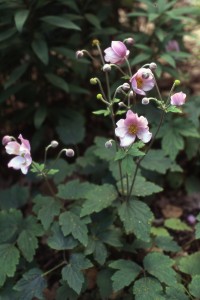
The long-flowering Japanese anemone cultivar 'Robustissima'
• Does the plant have attractive, prominent flowers? (Finally!)
• Do the flowers have a scent that’s nice, objectionable or simply absent?
• Do the flowers last a long time?
And there you have it: questions about flowers are in last place. Now, I want to clarify something. I understand perfectly why so many home gardeners give in to the temptation to fill their properties with plants having beautiful flowers. Beautiful flowers are lovely to look at—it’s as simple as that. The problem is that we don’t live in an ideal world. Flowers fade, and most perennials only produce flowers for two to three weeks every year under the best of circumstances. That’s not very long, so if you pick plants based on how well you like their flowers, you won’t get much bang for your buck.
I’m not saying that you should ignore a plant’s flowers when making choices. For instance, it is true that a small number of perennials will flower for a longer-than-average time, and can be worthwhile making room for these plants in your garden for that simple reason. One example is the Japanese anemone pictured above. I’m just saying that most of the time you should only be considering the flowers of plants that have passed muster in a lot of other ways first. Flowers should be your last consideration, not your first.
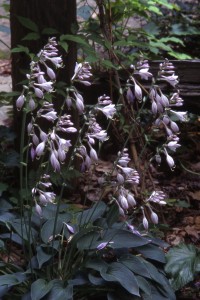
Cut these hosta flowers off? Not me!
In my next blog post, I’ll elaborate a little more on what makes a superior shade perennial and share a few examples.
Lessons from a Tough Year
January 3, 2010 by admin
Filed under Garden Design, Perennials
2009 was the worst growing season in about a decade. Here in the Northeast, it started out as “the year without a summer” and then became “the year with the summer we wish hadn’t come after all.” After a long, ultra cool and rainy spell it became stiflingly hot and humid practically overnight. Only in September did it become tolerable, but it remained erratic.
While I don’t want to see another year like 2009 any time soon, difficult weather years provide good opportunities to learn valuable gardening lessons. Weather, of course, has a big influence on garden beauty (or ugliness) mostly because of its impact on plant health. When plants struggle, gardens don’t look good. 2009 was a year in which lots of plants struggled.
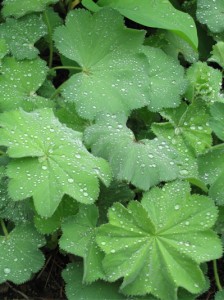
In 2009, lady's mantle withstood weather that devastated many other plants.
Mostly it was a matter of disease. If it was fungal, we had it here in the Northeast: powdery mildew, late blight (along with every other kind of blight), rust, rust and more rust, and rots I couldn’t begin to identify. At one point I heard informally that commercial plant growers were spraying fungicide at unheard-of rates. It wasn’t hard to believe. I, too, sprayed things I’ve never sprayed before in hopes of nipping diseases in the bud, but many normally reliable performers succumbed. The undersides of Hydrangea arborescens leaves became a mass of orange pustules before dropping off prematurely. Snapdragons bloomed half-heartedly and then rotted at the base. Even hostas, normally great performers, were a total loss—not because of disease, but because 2009 was also a record-breaking slug year!
So, what was still looking good at the end of that horrendous season? In the shade department, Hellebore, Epimedium, Siberian bugloss (Brunnera), Geranium macrorrhizum, Rodgersia, white wood aster (Aster divaricata), Heuchera villosa ‘Autumn Bride’, wild ginger (Asarum), ferns and (in light shade) astilbes and lady’s mantle (Alchemilla) were some of the best performers among perennials. That’s what I’d expect. These plants always look good. Any shade garden designed for long-term low maintenance and long-season interest in the Northeast (as long as it’s not a native plant garden) should be made up primarily of plants like these.
Among sun-loving perennials, many North American natives really showed their strength. Bluestar (Amsonia tabernaemontana), turtlehead (Chelone), tickseed (Coreopsis), purple coneflower (Echinacea purpurea), Helenium, Rudbeckia fulgida and Culver’s root (Veronicastrum virginicum) all sailed through summer. Phlox maculata ‘Rosalinde’ proved once again why it’s superior to every other phlox out there.
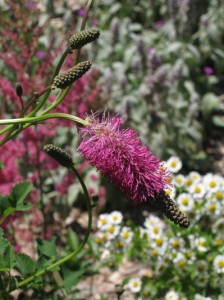
Burnet (Sanguisorba) looks delicate, but it came through 2009 with flying colors.
Among the non-natives, catmints (Nepeta), daylilies (Hemerocallis) and betonies (Stachys) of all kinds seemed no worse for wear, as did some lesser-known perennials such as burnet (Sanguisorba). Grasses showed a lot of resilience, although some didn’t attain their normal size because of the extended cool spring (most ornamental grasses need sun and heat to develop). The story is the same here as for shade plants: the ones that looked good at the end of 2009 were the ones that always look good.
So what’s the lesson here? To fill your garden with plants that are naturally disease resistant. They are the only ones capable of looking good whatever the weather delivers, and 2009 was the proof of that pudding. It’s fine to have some plants you just like a lot, even if you know they’re temperamental, but a garden full of them will eventually disappoint.
This winter, if you’re thinking about making additions to your garden in 2010, my advice is to pay careful attention to the invisible qualities of plants, like disease resistance. They’re the equivalent of a great personality in a human being—they may not be what you notice first, but they’re what you’ll grow to appreciate in the long haul. And with that thought in mind, here’s to some easier gardening years in the coming decade!
August Asters
August 21, 2009 by admin
Filed under Perennials, Summer, Summer Bloomers
We’ve all heard the expression “familiarity breeds contempt.” Well, it’s as true in the garden world as in the great wide world. Some of the best garden plants grow wild all around us and never get the recognition they deserve because they’re, well, common.
Native asters are a case in point. The Northeast is aster country, home to handfuls of species, and they’re so widespread that even a short walk down a country lane in August will probably turn up half a dozen kinds.
Never mind that the taxonomists have been at it again and the genus Aster was recently carved up and parceled out into several new genera including Eurybia and Symphyotrichum. “August Symphyotrichums?” I think not. I say if it walks like a duck and talks like a duck, it’s an aster…or, well, you know what I mean.
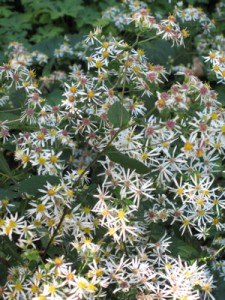
White wood aster is as close to a no-care plant as a plant can get, and native to boot
I have a soft spot for asters, especially the delicate roadside kinds, because they start to bloom at just the time of year when it doesn’t seem like anything should be able to look good. “Sticky heat” is a typical mid August weather forecast in this part of the world, and I know those conditions don’t exactly bring out the best in me. In fact, the word that usually springs to mind when I think of August is “awful!” But when I’m feeling like a wrung-out dishrag, asters are just starting to look cool, fresh and flowery.
Two of the best native species have begun to make headway in the gardening world in the last couple of years and are no longer strictly speaking “specialty plants.” Major plant growers are now propagating them, and you should be able to find them or order them at good nurseries.
My favorite native roadside aster is white wood aster (Aster divaricatus, recently rechristened Eurybia divaricata—yuck!). I frequently say that there’s no such thing as a no-care plant, but if forced at gunpoint to name the closest thing, this would be it.
White wood aster is a well-behaved plant, growing only about 24″ tall and completely capable of supporting itself. Its stems are black and its leaves broad, medium green and attractive. It’s been in the vegetative background for several months now, just growing slowly and steadily, but in the past week its flowers have begun to pop, making it more noticeable.
White wood aster is like a black sweater in your wardrobe-it goes with everything. It’s a little too tall to plant at the very forefront of most gardens, but set back a foot of two in your border it will shine no matter what its companions. White wood aster is sometimes offered under the cultivar name ‘Eastern Star’. To be honest, I can’t see any difference between the species and the supposedly improved cultivar, so don’t fret the presence or absence of a cultivar name.
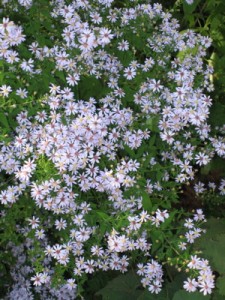
Blue wood aster in all its flowery August glory
The other aster I await with anticipation every year is blue wood aster (Aster cordifolius, recently renamed Symphyotrichum cordifolium—double yuck!). It can grow to four or even five feet in height, and if not staked it will flop over. If grown with enough other tall things around it, it can simply drape itself over them prettily. Possible garden cohorts might include Japanese anemone (Anemone x hybrida), yellow waxbells (Kirengeshoma), toad lily (Tricyrtis), turtlehead (Chelone), snakeroot (Eupatorium rugosum) and northern sea oats (Chasmanthium latifolium).
If you don’t stake it, I’d recommend pinching it early in the season when it reaches a height of two feet or so. You don’t have to get fussy and give it a $100 haircut. One good whack with a pair of hedge clippers, removing up to half the growth, will do the job. “Pinching” it in this way will also delay flowering somewhat, as pinching usually does. You can treat white wood aster the same way if you want it to be shorter or bushier for any reason.
As its name suggests, the flowers of blue wood aster are blue, although personally I’d call their hue more of an icy violet. It’s an interesting color that changes depending on the quality and angle of the light, making the plant something to go out of your way to see at different times of day and in every kind of weather.
Blue wood aster is most frequently offered in a form called ‘Avondale’. It does seem to me that ‘Avondale’ is more floriferous than the straight species, but you can’t go wrong with either one.
White wood aster and blue wood aster share a pair of wonderful traits. First, they aren’t prone to powdery mildew. This common, disfiguring disease afflicts many New England and New York asters, but you’ll see nary a trace of it on the duo I’ve described for you here.
Second, they’ll bloom well even in moderately shady conditions. (Most of the asters traditionally offered in garden centers require full sun to do well.) In fact, I’ve never grown them in anything but some degree of shade, and I’d be curious to get a report on their performance from readers who have used them in full sun. I wouldn’t recommend putting them in deep shade, however. I’m using nature as my guide here-I never see them growing in such a situation in the wild.
So, grant these two lovely native asters the respect they’ve long deserved and give them pride of place in your garden. They’ll give you, too, something to anticipate in “awful” August.
Spring Blooming Shade Plants: Hellebores
March 18, 2009 by admin
Filed under Perennials, Shade Gardening, Spring Bloomers
In a typical year, hellebores will be the first ornamental perennial to bloom in the Northeast. Although there are several species that can be grown in this region, especially in milder areas such as the coast and the lower Connecticut River Valley, one of the hardiest remains my favorite: Helleborus x hybridus (formerly and sometimes still known as Helleborus x orientalis).
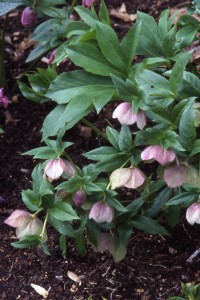
Helleborus x hybridus
Here in northwest Connecticut, hellebores send up their flower buds first, in March, before their leaves unfurl. As the month goes on, these succulent and tender looking shoots grow taller and taller, until they finally open up around April 1 to reveal clusters of 2″-wide, pendant blossoms. The species H. x hybridus is quite variable, with a range of subtle flower colors including creamy white, apple green, pale pink and burgundy. Its flowers often have striking speckled markings and prominent yellow anthers that are showy for about a week until the stamens fall off.
At first, hellebore flowers look a bit undressed because the plant’s leaves don’t come along until a few weeks later. When they do make their appearance, however, they are exceptionally attractive—leathery, glossy, palmate (arranged like fingers around the palm of a hand) and semi-evergreen.
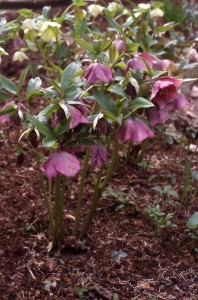
Hellebore flowers emerge before leaves
Everything about hellebores is long lasting. Instead of dropping off after 2-3 weeks, hellebore flowers slowly fade to a pale green or buff color in much the same way hydrangea flowers do. They look good (although subdued) right up to the point when the seeds mature and are dispersed, usually in the latter half of June. Deadhead them before that point unless you want seedlings the following spring. In most gardens, the leaves will remain disease free and unblemished all season long, and will still be looking good when the first snow flies.
Shade tolerance: High
Hardiness: Zone 5; other species may differ
Size: Medium sized, with a height and spread of 15-18″
Native status: non-native to any part of North America
Growing Tips
- Don’t cut back hellebore foliage in fall, even if you clean up the rest of your garden then. Why? Hellebores come up so early in the year, they are subject to damage from late frosts. These frosts won’t kill the plants, but they will kill the flower buds. As the plant’s shoots begin to emerge from the ground, last year’s leaves will provide some protection. After the new shoots have grown taller than last year’s leaves, you can groom them, cutting off the old foliage at ground level. Be careful not to accidentally cut off new growth—it’s easy to do. For a few more weeks after you groom them, it’s a good idea to keep some pine boughs or an equivalent handy to gently arrange over the new growth at night if a hard frost is in the forecast.
- Hellebores have to be several years old before they are mature enough to flower. A nursery plant in a 5-pint pot is probably only two years old, so don’t be surprised if it doesn’t flower its first (or even second) year in the ground. As long as the plant grows well and looks healthy, flowering should start when the plant is ready. A plant that fills a one-gallon pot should be old enough to flower its first spring after planting.
- H. x hybridus is often sold in a mix of undifferentiated colors. In other words, if the tag in the pot with your plant does not specify a flower color, but just says H. x hybridus, it could be any of the flower colors listed above. There’s no way to know which color you’ve got unless you buy the plant in bloom very early in the season and the plant is old enough to be blooming in the first place. In recent years, some growers have also offered hellebores in designated colors. I like the way the mixed colors look in the garden when hellebores are massed, but gardeners with color-theme gardens might prefer to purchase all of one kind.
- Hellebores have no special needs, but they don’t like excessive moisture. If put in exceedingly dank locations or planted in soils that drain poorly, rot of the crown may result.
- Hellebores self-sow moderately. Their seeds are large and heavy, so they don’t usually travel very far. If you don’t deadhead your plants before they drop their seeds, you’ll probably find a “skirt” of seedlings around their feet in spring. Move these to a nursery bed to mature or give them away to friends.
Bloom times and other life cycle stats are accurate for northwest Connecticut. In milder areas all aspects of a plant’s life cycle may occur earlier in the year, and in colder areas, later.

